Denmark's History
37. Erik Ploughpenning
1. Introduction
Erik Ploughpenning was the son of Valdemar the Victorious, and he ruled Denmark from 1241 until his death by murder hand in 1250 in a boat on the fjord of Slien.
Valdemar the Great had in 1147 raised the cowed and anxious Danes to resistance against the Slaw pirates and conquered the island of Rugen. Under his eldest son, Canute the Sixth, the Danes conquered all the Slaw homelands in Pomerania and parts of Mecklenburg, and the Slaws hailed him as their king. Under his younger son, Valdemar the Victorious, the conquest of the entire land north of the Elbe including Holsten was completed.

Erik Ploughpenning on copper engraving from about 1700. It is highly questionable whether the artist had any knowledge of what he looked like. But he did have a Portuguese mother, so he probably imagined that he looked a little "Portuguese", a dark type with small eyes, certainly excessive. But also the frescoes in Sct. Bendt's Church in Ringsted, painted a few years after his death, indicate that he was a slightly dark type.
Note that he is called Erik 6. In our traditional line of kings that starts with Gorm the Old, however, there are only three Eriks before him, and he should thus be called Erik 4. However, this can be explained by the kings being originally considered to be "Jutes'" kings, who later were elected kings for all of Denmark. And in the life of Anskar, are told about the two missing Eriks who were Jutes's kings. "Vita Anskarii" says that while Anskar stayed in Sweden, the prospect of resuming the mission in Denmark disappeared. Erik, King of Jutland, who had previously supported Anskar, had become unpopular with his pagan subjects, and in a battle that lasted for three days, he and almost all his closest men were killed, and his only descendant, Erik 2. was left as ruler over only a small part of Jutland. Photo: Det Kongelige Bibliotek
However, the same Valdemar the Victorious lost the entire North German area again a few years later when he was kidnapped by Count Henrik of Schwerin during a hunt on the island of Lyø - which resulted in the river Eider again becoming Denmark's southern border, as it had been for centuries. But regardless of the loss of the area north of the Elbe and the other former Slaw areas, the time of Valdemar the Great and his two sons were a period characterized by peace, progress and prosperity.
However, the nation's heydays came to an end at the death of Valdemar the Victorious and his son's, Erik Ploughpenning's, ascension in 1241. Not that this can be blamed on King Erik, who was a man of many good qualities, but it was a logical consequence of a development that had been going on for a long time before he became king.
A monk in Ryd Kloster near Flensborg Fjord wrote in the monastery yearbook: "Valdemar the Second died on Maundy Thursday. When he died, the crown really fell from the head of the Danes. After his death, countrymen began to quarrel and fight and injure each other - to mock and scorn for them in all the countries around - and the land that their ancestors had won with swords and victories became lost for the crown because they could not agree, and it has since mostly become the cause of the adversity and harm that we now experience daily. And all this has the lords themselves caused by fighting each other. As the Lord says in the gospel, "Every kingdom at odds with itself is wasted." - "Furthermore King Erik - the son of Valdemar the Second - became king of all Denmark."

|
Royal genealogy throughout Denmark's history. But, all kings - except Magnus the Good - are descended from "Hardegon, son of a certain Sven", who captured a large Part of Jutland around 917, as narrated by Adam of Bremen in his section about bishop Hoger. The line of kings and stories of war and peace are the backbone of history - not so that accounts of culture and ordinary people's living conditions are not important and interesting, but without the line of kings they easily become unstructured narratives that are not easily and immediately fixed in time. It gives a good overview of dividing the line of kings - and thus the history of Denmark - into manageable sections.
The Knytlinge genus has its name from Hardecnudth, probable son of Hardegon. He is also called Knud the First and was Gorm the Old's father as told by Adam in the section of Unni. Magnus the Good, who became king in 1047, was the son of the Norwegian saint, king Olav; his reign constitutes a transitional period into Sweyn Estridsson and the time of his sons and grandsons.
The rivaling kings, Svend, Knud and Valdemar, until 1157, all descended from Sweyn Estridsson; their time forms an interregnum for into the Valdemars' era.
Many historians, probably most, include only Valdemar the Great, his son Canute the Sixth and Valdemar the Victorious to the Valdemars. But one cannot claim such a definition, and it seems appropriate for the author to also include their less successful descendants - including Erik Ploughpenning, Abel and Christoffer 1. - until Christoffer 2. who was the last king before Denmark's kingless period around 1340.
Valdemar Atterdag was not king of the Kalmar Union, but his grandson, Olaf, was and his daughter Margrete 1. became the reigning queen of the Scandinavian Union. One can say - with good intention - that Valdemar Atterdag recreated Denmark and thus the possibility of the Kalmar Union with Norway and Sweden.
The early Oldenburg kings were also kings of the Union but only for short periods.
The Civil War, The Count's Feud, to 1536, was a conclusive turning point in the history of Denmark. As a consequence of the Lutheran Reformation, which took place at the same time, the kings confiscated the third part of Denmark's agricultural land that belonged to the church. This amazing wealth enabled them to cue Denmark's old nobility and create the absolute monarchy, which was a decisive reason for the country's historic downturn. In 1848, a democratic constitution was introduced without civil war or other events of violence.
The Oldenburg Dynasty became extinct in 1863 with the childless Frederik 7. The throne was then given to Christian 9. of Glucksborg.
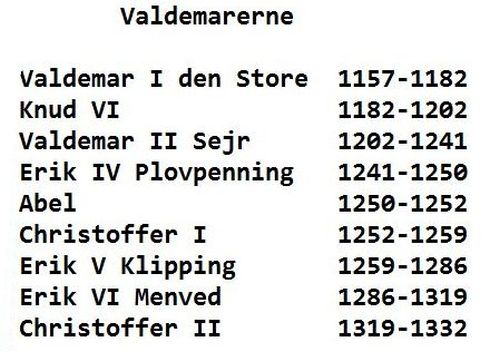
The Valdemars. It is common simply to count only Valdemar the Great, Canute the Sixth. and Valdemar the Victorious as the Valdemars. But in doing so, their less successful descendants become educationally homeless, despite being direct descendants of the first Valdemars, and not being separated from them by any natural transformation period. Therefore, I would suggest that until the kingless time the whole group to be called the Valdemars.
Erik Ploughpenning, Abel and Christoffer were sons of Valdemar the Victorious and succeeded each other as kings. Abel most likely killed his brother, Erik, and immersed his body in the fjord of Slien. However, 24 knights swore that Abel was innocent and therefore he could still be elected as king. However, shortly after he was killed in action in a battle during a campaign in Frisia. His little brother Christoffer was chosen as his successor as king, and the eldest son of the deceased king Abel was bypassed. This led to a long-standing rivalry between the descendants of Abel and the descendants of Christoffer in the following decades.
Christopher's son, Erik, who later got he byname, Klipping, became king only 10 years old with his mother Margrete Sambiria as a guardian. The chieftains limited his power with a charter of rights at the Danehof meeting at Nyborg Castle, which, among other things, stated that this meeting of the king and the great men, who was later called Danehof, should be the country's highest court. Furthermore, it was held that the royal court should not deal with cases, which had not previously been presented to another court and that it should only impose standard penalties. Erik was killed in Finnerup Barn near Viborg with 56 stab wounds - one of the great mysteries of Danish history. His son Erik Menved tried to create goodwill and increased influence in Northern Germany by holding some magnificent knightly tours. He was followed by his brother, Christoffer 2. who had to take over the brother's large debt, while he was blocked the possibility of increasing the crown's income by a charter. When he died in 1332, no new Danish king was elected, and the country was for a period without king.
During hundreds of years, kings and great men had bequeathed estates and villages to the monasteries and churches for the salvation of their souls, areas which then became subjected to the privileges of the church, including freedom of taxation to the king. It was a development that only went one way. Churches and monasteries were immortal and they never let go of anything they once had got.
Bishops and abbots mostly came from the country's best and richest families, they managed vast expanses of land almost like a state within a state. The church had grown large and strong and had become an independent power factor that no longer relied on the royal power but on the contrary could make demands on it.
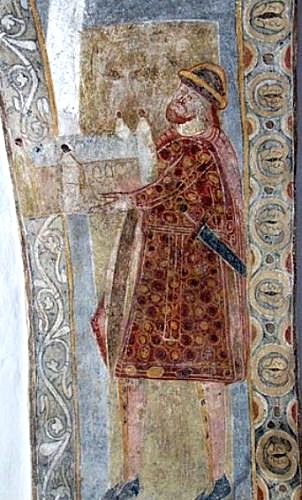
Founding image in Gerløv Church in Western Sjaelland, which shows a man in Russian Bojar Costume, who hands the church to the congregation and God. Some believe it is Esbern Snare, who is said to have accompanied the king on a trip to Russia. Esbern Snare was one of the great heroes of the Hvide lineage. Photo Øresundstid.
Moreover, it had become common to give parts of the country as fiefs to the royal princes, who were not going to inherit the throne, to ensure them a sufficient noble and decent position. In doing so, these princes were granted the right to most royal revenues in the territories which were granted to them, and the king's revenue was cut accordingly.
In this way, the royal revenues became ever smaller, and the king's potential political enemies' revenues increased. The king's power became weaker compared to the church and the rulers of the fiefs, and the society thus became more politically unstable, as it became much more difficult for the king to crush a rival king-candidate with overwhelming strength.
Another factor which weakened the royal power was that the mighty Hvide lineage, who had created Esbern Snare and Absalon, and who had loyally supported the king's power under Valdemar the Great and Knud the Sixth, turned in irreconcilable hostility to Erik Ploughpenning.
The first known sign of the Hvide lineage enmity against King Erik was the king's break with his chancellor Bishop Niels Stigsen of Roskilde, who had to flee the country and see the king seize his city Copenhagen. Bishop Niels' brother Juris Stigsson was killed in 1246, allegedly by his own housecarls. Erik deprived Peder Ebbesøn - who belonged to the Hvide family - of his bailiff's office, which led to him having great reluctance towards the king. Lave Gudmundsson, who was married to Esbern Snare's granddaughter, and Tyge Bost, who according to his coat of arms belonged to the Hvide family, were Erik Plovpenning's special deadly enemies. Anders, a son of Esbern Snare's daughter, Ingeborg, immediately in 1250 became Abel's marsk.
The cause or causes of the enmity between King Erik and and the Hvide lineage is unknown, but it became fatal to Erik Plovpenning as Tyge Bost and Lave Gudmundsen - both of of the Hvide lineage and in Abel's service - were responsible for his death in the boat on the fjord Slien.
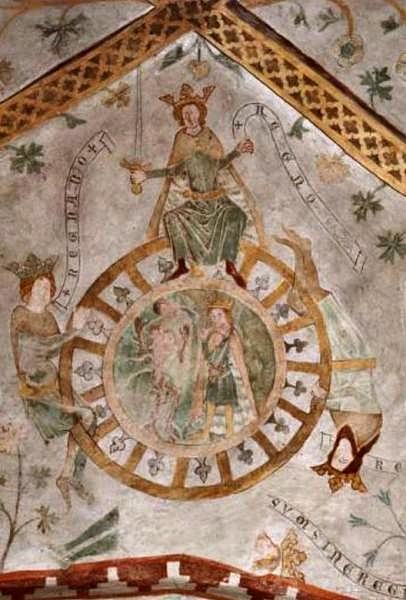
Mural from 1325 in Birkerød Kirke between Lyngby and Hillerød, which shows the wheel of fortune. The text strips say: Regnabo (I will be king) - Regno (I am king) - Regnavi (I have been king) - Sum sine regno (I have no kingdom) Photo kalkmalerier.dk.
Some historians traditionally tune in with the monks: "After his death, compatriots began to quarrel and fight and harm one another - to mock and scorn for them in all the countries around" - "As the Lord says in the gospel: "Every kingdom in disagreement with itself will be left deserted." - "And what else can you say? Sadly, they both claimed power and brought the kingdom in great disrepute in all countries, and both wanted the other dead."
As if the responsibility for the disasters was equally divided between two immature male fighting chickens, Erik and Abel, and the monks themselves were the only mature and sensible ones. Only few point out that one brother, Erik, was the legitimate, legal king of the country, while the other brother, Abel, was a rebel and basiscally a traitor, who led foreign armies against Denmark to achieve his own political goals. The church and the monks had their own agenda, they simply stood at the sideline and wailed without choosing a side or addressing the problem.
Erik Ploughpenning had, by all accounts, understood that the constant gifts to the church in the form of estates and villages and the ever-increasing privileges of the church in the form of tax exemptions undermined the royal power to the detriment of the country's stability and thus its peace and prosperity. If he had not lost his life, he might have become one of Denmark's great kings, who would have corrected the imbalances that had occurred during his predecessors.
2. Erik Ploughpenning
In 1226, Valdemar's and Berengaria's three sons succeeded their half-brother, Valdemar the Young, as hostages at Henry of Schwerin. Erik was 10 years old at this time, Abel 8-9 years old and Kristoffer 7 years old. They had to stay in Schwerin until 1228, when Count Henry died, or until 1230, when Valdemar the Victorous paid the last installment of the ransom. Their mother Berengaria died already in 1221, when Erik was 5 years old, the boys may have had no clear memory of her.
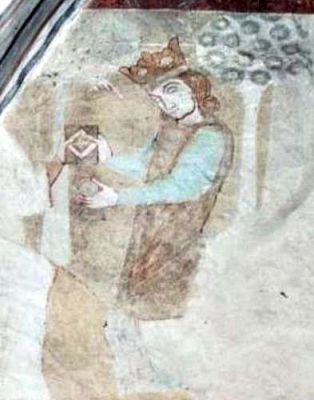
Fresco from 1250 showing Erik Ploughpenning in Tømmerup Church near Kalundborg. Photo kalkmalerier.dk
We must believe that Erik very much has had the role of big brother, and that has contributed to a natural self-confidence.
Despite the fact that his three sons, Albert of Orlamunde and other Danish great men, were still hostages in Schwerin, Valdemar gathered an army and broke into Holsten in 1226, thereby challenging Count Henry of Schwerin, who was allied with Adolf of Holsten.
Several historians state that Erik studied in Paris, like so many other sons of Danish great men. Here he should have met another student, who would later become pope by the name of Innocent 4. However, it is hard to see that this pope granted special favors to Erik during his reign, except for decisions related to Erik's plans for a crusade to Estonia. On the contrary, Innocentius supported Jacob Erlandsen, who would later cause so much trouble for Denmark.
His older half-brother Valdemar the Young died as a result of a accidential shot during a hunt on Røsnæs in 1231. Subsequently, Erik was crowned as his father's, Valdemar the Victorious' co-king on May 30, 1232.
In 1239 he married Jutta of Saxony, who was about 16 years old at this time. With this marriage, Denmark reconciled with Albrecht of Saxony, whose participation in the battle of Bornhøved on the side of the counts was crucial to the victory over Valdemar the Victorious.
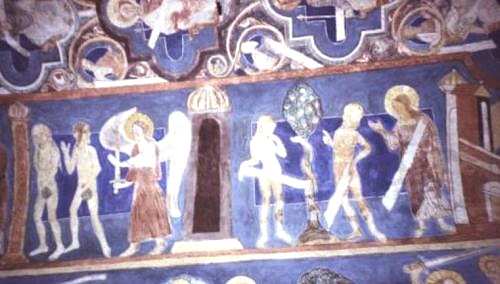
Fresco from 1200 illustrating the expulsion from Paradise in Bjäresjö Church northwest of Ystad. Photo kalkmalerier.dk.
Pope Gregory 9, in 1240, invited Erik - who was then 24 years old - to be elected German counter-king to Emperor Frederick 2. But, on the advice of his father, he refused to get involved in German politics. However, it shows that Erik was regarded as a gifted and talented young man, whom many had high expectations for.
Erik took his duty s a king with the utmost seriousness. The contemporary German poet Reinmar v. Zweter says of him: "He was obliging to his own, but terribly against his opponents" and the same source continues: "in his younger years he was busy with fun and amusements and as a sensualist he was strongly devoted to the world" but he underwent a sudden transformation when he succeeded his father as "his mind turned more than that of princes usually from love to the worldly."
The Sjælland Yearbook tells of King Erik that he: "was a very handsome man and a very gentle knight, he was very kind to everyone, and he accomplished many beautiful deeds." An old line of kings that tells extensively about Erik Ploughpenning's death also speaks of the king's beautiful and endearing exterior.
A monk in Øm Monastery wrote: "He was kind to the whole kingdom, loved by God and humans."

Fresco painting in Keldby Church on Møn from 1325, depicting the flight to Egypt. Photo kalkmalerier.dk.
Despite his sometimes strained relationship with the church leaders, he was a seriously believing Christian. Immediately after becoming sole king, he issued a letter in the presence of Queen Jutta, the Franciscan monk Ulrik and the king's priest Peder, in which he announced that he would die in the cloak of a gray brother and be buried in Roskilde Franciscan Monastery. As we know, he did not get fulfilled his wish.
Throughout his reign he wanted to go on a crusade to Estonia. It came to nothing, basically because he dared not turn his back on his brothers and other enemies in Denmark.
Another monk in the Øm Monastery complained in 1242 about Queen Jutta's disrespect for the monastery's property. By this time she had been married to King Erik for about 3 years, and consequently she had only lived in Denmark for as long. One must think that she had got her attitudes on the monastery's ownership of Denmark's resources from people who were close to her, for example from her husband, the king. The monk wrote: "King Erik's queen, whose name was Jutta, who lived at Skanderborg at that time, confiscated every day from our farm in Tørning with force what she wanted. It went so far as to threaten Brother Olaf Kviter, who was in charge of this barn, as well as abbot Jens and the other brothers, that she would do them harm to their life and limbs if they did not let her do with our property, what she wanted. And when, as usual, we drove our grain from Djursland to the Monastery, the queen ambushed us in many places along the way to rob this, if an opportunity appeared.
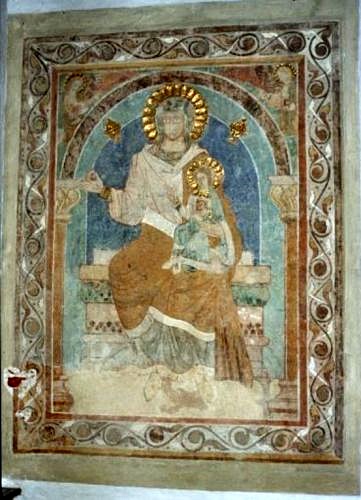
Mural from around 1200 in Bindslev Church northeast of Hjørring, which depicts the Virgin Mary with the Jesus Child. Photo kalkmalerier.dk.
In addition, Erik took advantage of Roskilde Bishop Niels Stigsen's escape to take possession of Copenhagen and the associated fortress, which otherwise belonged to Roskilde diocese, which also suggests that he believed the church had become too powerful.
When the Civil War flared up again in 1250, Erik faced a formidable coalition consisting of Duke Abel of Slesvig, the Holsten Counts, the Hvide family and Lubeck, yet he completely overcame them the same year by finally occupying the city of Slesvig and the Rendsborg fortress. He could only do so in such a short time with the support of the overwhelming majority of the Danes.
3. Erik Ploughpenning as King of Denmark
In 1241, Erik succeeded his father, Valdemar the Victorious, on the throne.
Immediately, Erik continued his predecessors unfortunate practice of giving privileges to churches and monasteries to save his soul.
At Roskilde Magister Bo's request, he thus gave the prists of Roskilde's estades, peasants and crofters free of the duties and taxes, leding and stud, and whatever other weights that hitherto had rested upon them. In return, the priests promised that they would hold a mass for the king daily at their own expense, both while alive and after his death. He later reaffirmed, among other things, the privileges of the Ribe Cathedral, Aarhus Cathedral and the Odense Knuds-brothers.
In 1248 he bestowed on Bishop Esger of Ribe a skiben in Hvidding Herred - perhaps as a reward for his merits in the war against Abel.
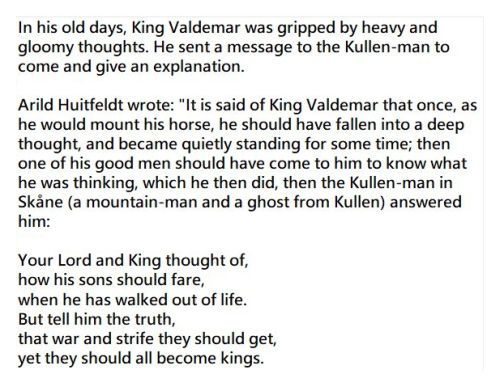
The Kullen-man's answer to King Valdemar the Victorious.
Another monk in the øm Monastery complained about 1242 about Queen Jutta's disrespect for the monastery's property. The monk writes: "Also King Erik's queen named Jutta, and who at that time lived in Skanderborg, confiscated every day from our farm in Tørning by force what she wanted. It went so far as to that she threatened Brother Olaf Kviter, who was in charge of this farm, as well as Abbot Jens and the other brothers, that she would cause them harm to life and limb if they did not let her do ith our property, what she would. And when we came as usual with our grain from Djursland to the Monastery, the queen ambushed us in many places along the way to rob this if an opportunity appeared." - "Everything we owned of ships or boats we destroyed so they could not be repaired, or we sank them, lest the queen's men should use them against our will to carry our goods from the monastery to Skanderborg, For though we would have objected to this, we would not, however, have the courage to do it, defenseless and unarmed as we were." The fact that the Queen found such Robin Hood methods necessary also indicates that the royal incomes were not impressive.
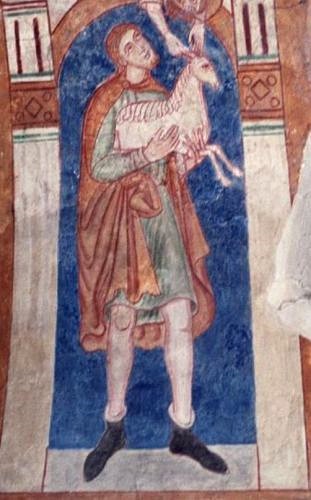
Mural from around 1200 in Engum Church near Vejle depicting Abel's sacrifice. Cain and Abel were the sons of Adam and Eve. Cain was a farmer and brought a sacrifice from his harvest. Abel was a cattle breeder and brought a sacrifice from his animals. God accepted Abel's sacrifice, but not Cain's.
Photo kalkmalerier.dk.
"The dispute began between the two brothers King Erik and Duke Abel." Ryd Monastery Chronicle tells for the year 1242. "In addition, Ringsted Monastery burned. The Nonnery of our Lady in Roskilde also burned."
Sjælland's Yearbook describes the cause of the dispute: "There was a great disagreement between him and his brother, Duke Abel, which lasted a long time. Because Abel was married to a sister to the Count of Holsten, and these the king would in any way bring under Danish rule, but to defend them, Abel set himself against his brother and fought many times against him, aided by a German army."
Abel was different from his father. Valdemar the Victorious had no trouble respecting his brother, Canute the Sixth, as king and representing Danish interests as Duke of Slesvig. But Abel brought foreign armies into the country to defeat the king and to support his own interests, and this will usually be characterized as treason.
Throughout his reign, Erik worked for a campaign in Estonia - supported by the Pope. On February 20, 1243, the Pope promised everyone who would follow Erik on his crusade to Estonia the same sin-forgiveness as that given to the actual Crusaders. It is not clear which pope it was.
Furthermore, in 1243 Pope Innocentius issued a letter whereby, after Erik's request, he took him, his kingdom and all that he rightfully possessed of goods into Sct. Peders and his protection because the king "aflame with faith and pious diligent eagerness would go against the pagans and barbarians who molested the converts in Estonia." and reminded the Danish bishops to make sure that no one unpunished broke this papal commandment.
But the civil war raged on. In 1243, it came to pass that the two brothers faced each other with each their own army - the royal fraternity war now evolved into a civil war that harmed everyone, both high and low. Ryd Monastery Yearbook writes about the year 1244: "King Erik led an army against his brother - Abel - at Kolding."
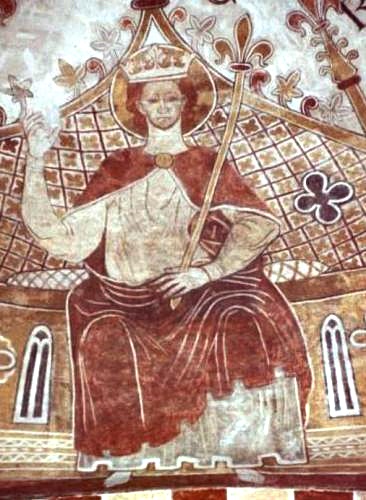
Fresco in St. Bendt's Church in Ringsted from 1275 showing Erik Ploughpenning on his throne. He is wearing the toga-like royal robe, which was so popular in the Middle Ages, at least on pictures of royal figures. In his left hand he carries a stick with the French lily - fleur-de-lis - which symbolizes the Trinity and the right Catholic faith. He has a saint glory when, as Denmark was trying to get him elevated as a saint because of his violent death. However, they did not succeed. One might think that he may have been a dark type, like probably his mother. Photo kalkmalerier.dk
The Pope complied Erik in his desire that "he over three years had to collect over one-third of the tithe, which would otherwise be paid to the churches with the only restriction that a small amount was reserved for light and maintaining of the roofs."
In 1244, Erik and Abel agreed to go on a crusade together. The occasion was probably that the Russian great prince Alexander Nevski in those years had given both the Swedes and the Knights of the Teutonic Order humiliating defeats. Erik and Abel really left, but only reached Ystad where they turned around. The reason is unknown, but we can imagine that they were informed that Alexander Nevski had already concluded a peace.
But in February 1245, a church meeting was held in Odense, where the pope's nuntius, John of Piacenta, was also present - a meeting which was definitely directed at the king. The main topic of debate was how to protect the church from the abuse of worldly power. On February 22, the meeting issued a curse on those who violated the Church's goods and rights "With the power of God the Father, the Holy Virgin Mary and this church meeting we band of all those who for profit or hatred or to obtain someone's favor or for any other reason with evil dare to deprive the churches their rights or with evil seeks to violate and destroy their freedoms, and all those who with violence and evil rob and attack church property, as well as those, who let such happen, order and promote it." The Odense Declaration was, in effect, a declaration of war against the kingdom.
It was not a new attitude that the bishops here revealed. We recognize the phrases from Jutland Law's opening speech from 1241: "All worldly rulers must also know that with the power God gave them in this world, he also assigned them to guard his holy church against all claims. But if they are forgetful or partial and not guard rightly, then on the Day of Judgment, they must be held accountable if the freedom of the church and the peace of the country is diminished because of them in their time." And we realize that the Danish Church has moved very far away from the bishops of King Niels, Valdemar the Great and Canute the Sixth, who stood firm with the King for the sake of Denmark and loyally followed him in war and leding.

Mural from around 1200 in Engum Church near Vejle depicting Cain's sacrifice. Cain and Abel were the sons of Adam and Eve. Cain was a peasant and brought a sacrifice from his harvest. Abel was a cattle breeder and brought a sacrifice from his animals. God accepted Abel's sacrifice, but not Cain's. Foto kalkmalerier.dk.
Erik Ploughpenning instantly understood that the Odense resolution was aimed at himself, and he immediately responded by taking down the church's most energetic spokesman, Bishop Niels Stigsen of Roskilde, who was also his chancellor. The bishop had to flee the country and the king seized his city of Copenhagen and the the castle there. It now came out that Niels had conspired with opposition circles and that Erik felt threatened on his life.
Ryd Monastery Yearbook mentions: "In addition, Bishop Niels of Roskilde fled out of Denmark."
The Lund Yearbook says that Bishop Niels Stigsen was expelled from his diocese not because of his own deeds but because of the evil of the king and his men. However, Erik was of a different opinion: "By speaking against him, he had retaliated good with evil, love with hatred, bread with stones and eggs with scorpions, yes, secretly, with some fellow conspirators and kinsmen, he had sought to take the kings life and kingdom, and had even committed himself to that by oath, finally he had also destroyed his estades." Niels Stigsen was of the Hvide family and his expulsion was the first testimony of enmity between it and the Danish king. We notice Erik's words: with some fellow conspirators and kinsmen."
The pope instructed Simon of Alvernia to judge Niels Stigsen's case and this one ordered the king that Niels Stigsen should return with safe conduct, give back Copenhagen to Roskilde diocese and likewise Niels' personal estades. As the pope went on to call a band, Erik imposed severe penalties on those, who obeyed the pope's orders.
The general unwillingness of the church princes to be available to the king cannot be doubted. Also in the year 1245, Innocentius gave through his representative "the king reminder and admonition to cease to force the bishops to, more than the church's ability, provide a large leding army at sea or on land." So here we have one of the abuses that the bishops believed the king had done to the church. He had demanded leding beyond what he was entitled to.
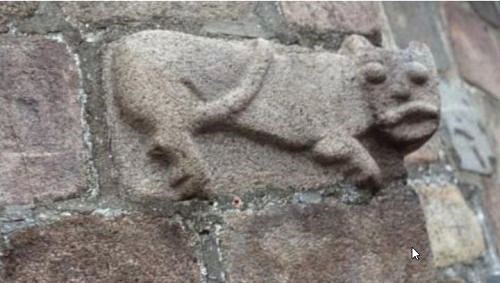
Romanesque Granite relief of a lion with a man's head in the wall of the Hedensted Church between Vejle and Horsens. Photo kalkmalerier.dk.
It is difficult to suppress that the pope was somewhat hypocritical. He wanted crusade to Estonia, but it should not be the church, which sourced the soldiers. Or that the pope suspected that these soldiers were not at all to be used for crusades, but to fight Abel and his allies in the civil war, and that the church was not interested in.
Also a papal letter to the archbishop of Lund reveals that the Danish Church's support for the king was superficial and reluctantly: "From our dearest son in Christ, the famous King of Denmark, we have been informed that although we have earlier by our letter given you a command to exhort and lead our brother, the bishop of Slesvig, to grant that King oath of allegiance and receive from him the regalia, as it is used to happen from ancient times to the present by virtue of custom, that has always been observed in peace and quiet, meaning that you, if it were to be necessary, should compel him to do so by our authority, yet you have not taken care of doing this. That is why we order you - "
In 1246, the war between Duke Abel and King Erik flared up again and worse than before. The King's second brother, Duke Kristoffer of Lolland-Falster, and his half-brother, Knud of Blekinge, openly stood on Abel's side, along with the Holsten counts and the town of Lubeck. Lubeck naval forces attacked the Danish coasts as the Slaws of their time, and King Erik's soldiers looted Fehmern and Svenborg, which belonged to Abel.
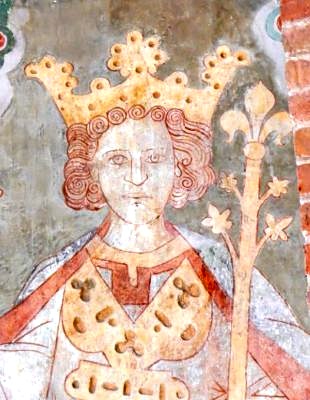
Mural St. Bendt's Church in Ringsted which is believed to represent Erik Plovpenning. Photo Wikiwand
The Lund Yearbook tells that Abel conquered Ribe on April 28, 1246: "a duce Abel eum melioribus Dacia" which means that Abel got help from Danish noblemen, maybe from the Hvide family. Several of the king's knights and soldiers were taken prisoner together with Bishop Esge. The Saxon World Chronicle, on the other hand, tells that Abel was supported by Count Johan of Holsten, the Bishop of Bremen and the city of Lubeck to conquer Ribe. The King conquered the city back in June same year and a subsequent attempt by Abel and his allies to recapture it had to be abandoned due to lack of food.
Erik and Abel's sister, Sofie, who was married to Mark count Johan of Brandenburg, Berlin's founder, decided to go to Denmark and reconcile her brothers, even though she was pregnant at the time and it was winter. However, she only reached Flensborg, where she had a miscarriage which caused both her and the child's death. She and the child were buried in Flensborg.
A settlement between Erik and Abel was made in 1246. Ryd Monastery Chronicle says: "King Erik led an army against his brother - Abel - and this one met him with a large army gathered in Germany, but for a while a settlement was made between them." However, the peace lasted only for a short time.
After the parties had lurked at each other, the fighting flared up again in late 1246. Abel had this time received reinforcements from his in-laws in Holsten and the Hanseatic city of Lubeck, whose trade king Erik seems to have created some obstacles for.

Mural from 1200 showing Jesus in Hedensted Church between Vejle and Horsens. Photo kalkmalerier.dk.
In 1247 there was still regular war between the two brothers, Erik burnt Svendborg. Haderslev and Aabenraa were also ravaged by the king's forces. Abel took revenge by burning down Odense and by ravaging Vejle and Randers.
Stade Yearbook says that Erik's German allies fell into Holsten and conquered the important city Olderlo.
Ryd Monastery Yearbook writes for the year 1247: "Both Sorø and Colbaz Monastery burned down. The Germans also burned Odense. The king also burned down Svendborg. And what else can you say? Sadly, they both claimed power and made Denmark a bad reputation in all countries, and the one wanted the other dead."
The Lund Yearbook tells of the following year, 1248, that Erik entered Arreskov on Funen, which probably belonged to Abel as his ancestral heritage. Næstved Yearbook tells that Erik captured both Kristoffer and Duke Knud of Blekinge and the King made a raid to Fehmern. But the Lubeck people freed Duke Knud from Stegeborg on Møn. Also, the youngest brother Kristoffer had escaped from his captivity, as it is told that at this time he married a Pomeranian princess named Margrete, who would later play a major role in Danish history bynamed Sambiria.
Several yearbooks say that it was this year that the Lubeck people burned and plundered Copenhagen, which was in the king's ownership since Niels Stigsen, the bishop of Roskilde, had fled the country. Resistance was done and several clerics were killed, but the result was that the city was taken and Absalon's castle demolished. Ryd Monastery Chronicle says"The Germans burned Copenhagen. In addition, Bishop Niels of Roskilde died in Clairvaux."

A fresco from 1200 depicting the dance around the golden calf and Moses with the tablets of the law in Bjäresjö Church northwest of Ystad. Photo kalkmalerier.dk.
The pope made an open declaration of war against Erik by unilaterally appointing Jacob Erlandssen as bishop of Roskilde instead of Niels Stigsen. However, he was not present in the country, and Erik appointed a magistrate Asgod instead.
But in 1249, a ceasefire was once again established, which Erik used to personally go to the Skåne county ting to extend the tax called "ploughpenning" to be collected in this region as well. But the peasants reacted very violently, and Erik had to flee with an excited crowd behind him. Shortly afterwards, however, he returned with an army and forced the ploughpenning tax to be collected in Skåne as well. But the Skåne ting peasants avenged themselves by giving him the nickname "Ploughpenning".
In the year 1250 the war broke out again and the king made great progress. Finally, he succeeded in conquering the city of Slesvig by a sudden assault, thereby forcing Abel into complete submission. The Sjælland Yearbook says: "Forced, the duke gave his life and goods into the king's hands and thus they became friends as it seemed; 20 noblemen and and knights swore on the duke's behalf, promising that if the duke ever opposed the king, to leave him and swear allegiance to the king."
The historian Kr. Erslev assumes that among the "goods" that Erik thus was assigned, was the fortress of Rendsborg, which Erik immediately occupied, and thereby Abel was cut off from his Holsten and German allies.
Erik continued with an attack on the Frisians, which did not, however, succeed. Lund Yearbook says that he had to withdraw with heavy losses.
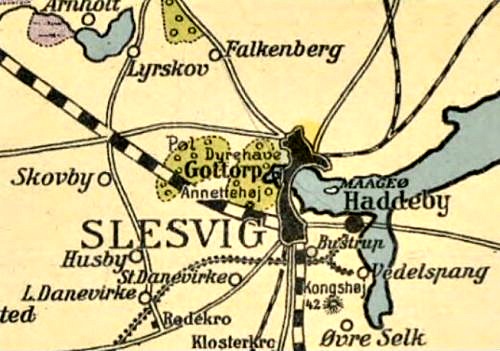
Mågeø on a map from 1913. In the 1100's Knud Lavard built the castle Skt. Jørgen Borg on the island. Here, in 1250 Erik Ploughpenning met with his brother Abel, who let him seize, decapitate and throw in the fjord.
The city of Slesvig, unfortunately now in Germany, bears many testimonies of the history of Denmark. In the streets of the city, King Niels found his death in 1134. Here, Canute the Sixth was crowned. North of the city is Lyrskov Heath, where Magnus the Good had victory over the Slaws. To the south of the city are Hedeby and Danevirke, who have been Denmark's fortification to the south for a thousand years.
Map of Slesvig city and Danevirke, detail from Gustav Rosendal's Southern Jutland map of 1913. Photo Gustav Rosendal - Kgl. Bibliotek Wikipedia
However, it seems that Erik and Abel had reconciled, as Abel appears several times under name of king in the spring of 1250 - Which may mean that Erik has followed old practice and made his brother a co-king. This, having given his brother such an honor and admission, may have made him so confident that he allowed himself to visit him in Slesvig - when he was on his way to Rendsborg with a rescue army - without adequate bodyguards.
It is about a letter in the Ribe City Archives: "given in Ribe in the year 1250 of the Lord, February 20" - "Abel, by the grace of God the King of Denmark and of the Slaws, Duke of Jutland, to all who see this letter, salute God ", and a similar letter in St. John's Monastery Archives in Slesvig: "Given in Slesvig in the year 1250 of the Lord, March 7" - "Abel, by the grace of God the King of Denmark and of the Slaws, etc."
However, Stade Yearbook and Sjælland Yearbook tell that the Holsten Counts, Archbishop Gerhard of Bremen and Bishop Simon of Paderborn prepared to recapture Rendsborg. They had 1400 riders, and in the first days of August they advanced towards Rendsborg, which the king had occupied with selected troops. However, the Germans had only been in front of Rendsborg for a few days before rumors surfaced that the king had suffered a major accident. Some said he had been taken captive, others said he was dead. The last story was true, and soon everyone knew, what misdeed had been done on Slien.
4. Erik Ploughpenning's Death and Burial
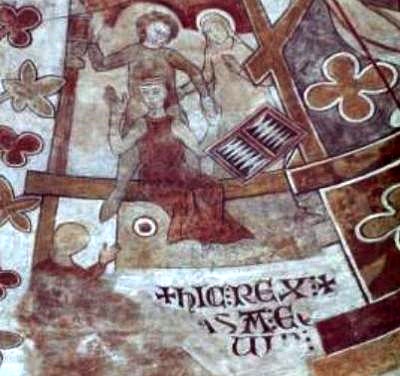
Mural in Ringsted Sct. Bendt's Church in Ringsted which depicts Erik being seized by Abel's men while playing a board game. "Here chess is played" the text says. Photo kalkmalerier.dk
Ryd monastery chronicle tells of Erik's death in 1250: "By treachery, Duke Abel captured his brother in Slesvig in the night of St. Laurentius, and one of Duke Abel's knights, named Laue Gudmundson, carried him into a ship. Then he killed him and lowered him into Slien."
The historian Erik Kjersgaard quotes a"contemporary chronicle", which is the Næstved Yearbook, which states that it has its information from "a man who knows the truth":
"When the king had been seized, the Duke said to him, "Remember that last year when you ravaged this city, my daughter had to flee barefoot and seek shelter among poor women!" The king answered, "Dear brother, be of good courage; for yet, by the will of God, I can afford to fully replace your daughter's shoes." The Duke replied, "You shall never do that!" - As there was no one who could be expected to free the king, the Duke left him in the custody of one of his knights, whose name was Tyge Bost. The knight asked the Duke, "To where shall I lead your brother, the King?" He replied, "Take him wherever you want, and do with him what you please."
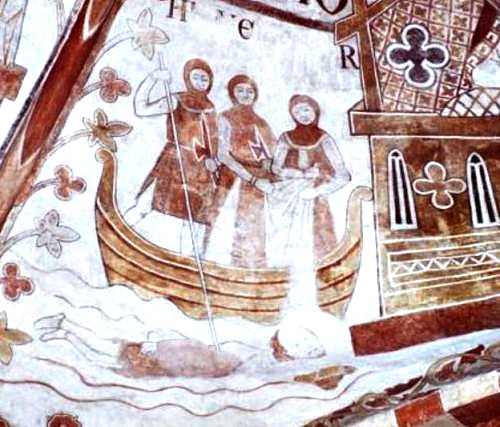
Mural in Ringsted Sct. Bendt's Church, which shows Abel's men lowering Erik Ploughpenning's decapitated corpse into the fjord of Slien. Photo kalkmalerier.dk.
"He and his men dragged quickly the king away between them, brought him aboard a boat that was at the bridge, and rowed away with him. Before they got very far away from the city, they heard the sound of strong rowing behind them and voices of rowing people, which encouraged each other to speed up. The king then said to his abductors, "Who do you think may be coming after us?" They replied: "We can hear from the voice that it is Lave Gudmundsen." The king then said, "Then I urge you, my dearest gentlemen, all who are aboard this ship, that you get me a priest to whom I may confess before I die; for I am sure that I will never escape from Mr. Lave's hands." They then sought a priest, found him by the grace of God immediately, and brought him out on the ship to the king. When the confession was completed, these servants of Satan seized the king, led him over to the western side of the Slien, decapitated him, and lowered the his decapitated body in the deep, after tying helmets and storm caps to the corpse.
But after a some weeks it was found by fishermen, brought to town and buried in the nuns' small church.
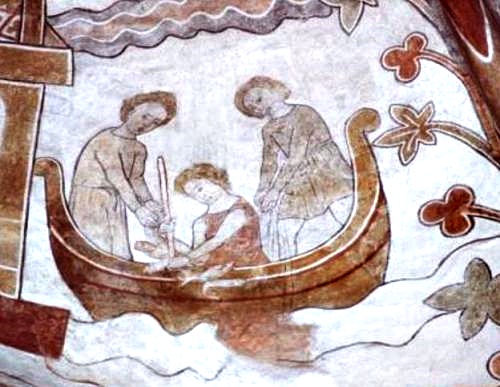
Fresco in St. Bendt's Church in Ringsted from 1275 showing fishermen finding Erik Ploughpenning's corpse. Photo kalkmalerier.dk
This report is broadly confirmed by a contemporary German chronicle: "while he (Erik) was safely sitting at a dice game in a house down by the water, Duke Abel, his brother, unexpectedly came over him, took him captive and with enemy hand threw him down into a ship that was deliberately brought to this place. He was led into the middle of this water, called Sli and Lave, one of the Danes' great men, whom the Duke appreciated, hurriedly arrived on another ship, decapitated him, and lowered his corpse into the depths of the water, weighed down by an abundance of iron, attached on it."
Hamburgische Kirchen-Geschichte for 1251 tells that a Hermanni Kerkwerder had played chess with King Erik of Denmark and had assaulted him and dragged him away and then killed him.
Lave Gudmundsen was of the Hvide family, a grandson of Esbern Snare.
Huitfeld in his "Chronicle of the Kingdom of Denmark" says that it took some time before the king's destiny became known: "For when Erik Plovpenning had been murdered, the crime was to be a secret; when the battered body came to light, it became clear what had finally been prepared for the king." Which lack of information was probably a precondition for that Abel could be crowned king shortly after the assassination.
The historian Olrik says that Erik's body had an existence full of changes. It "was lowered into the strait by chains, stones, and the king's helmet, but was taken up the next day by some fishermen and brought to the Dominicans of Slesvig, who silently buried it in their monastic church. Later, the corpse of the king, as it seems to be according to Abel's command, was moved to the nunnery on the islet of Slesvig, and again later, by Bishop Eskil, with honor, was taken to the cathedral, St. Peder's Church, in Slesvig."
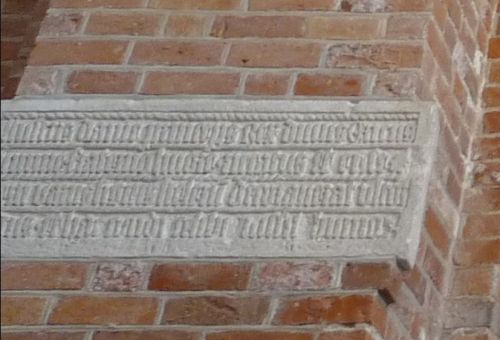
Plate with inscription on Erik Plovpenning's tomb in a column in Sct. Bendt's Church in Ringsted. Photo Arslonga
But in 1258, Erik's earthly remains were transferred to Ringsted Abbey, as it is told in his saintly script. Olrik continues: "Some of King Erik's bones, along with the chains, remained in Slesvig's Cathedral. The resting place that Erik got in Ringsted Abbey church appears to have been a very small grave at the foot of his half-brother's, Valdemar the Young's grave. But in the year 1520, Bishop Lage Urne had his bones taken up and walled in a column on the north side of the high choir, where an inscription was also made in his honor. At the 1855 survey, only very small residuals of bones were found."
5. Erik Ploughpenning's Daughters
Erik and his queen, Jutta of Saxony, had four daughters together, but no sons. Their names were Sofie, Jutta, Ingeborg and Agnes.
When their father was killed in Slesvig, the oldest, Sofie, was 9 years old, while the youngest, Agnes, was 1-2 years old.
Erik's widow, Queen Jutta, was just 27 years old, when he was killed in a boat on Slien. She quickly remarried - perhaps after the mandatory two years - with Count Burchard of Querfurt-Rosenburg in Magdeburg. But as royal princesses, the daughters had to remain in Denmark, where they were brought up at the court.
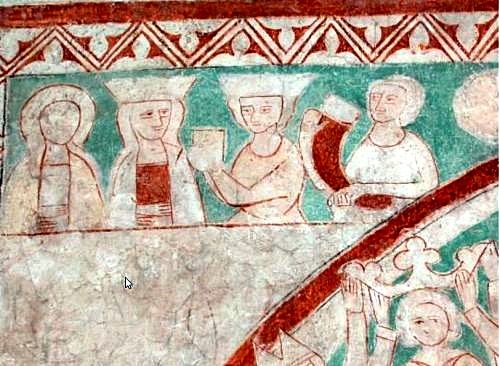
Mural from 1325 the royal wedding in Keldby Church on Moen. Notice a guest drinking from a rather large drinking horn - without a foot. Photo kalkmalerier.dk
The father's killer, Abel, became king, but he only lasted for two years until he fell in battle in Ditmarsken.
Thereafter, Erik's youngest brother, Kristoffer, became king with the dynamic Margrete Sambiria as queen. However, he died under suspicious circumstances in Ribe in 1259. Next, Kristoffer's minor son Erik - later to be bynamed Klipping - became king with his mother as guardian and thus guardian of Erik Ploughpenning's four daughters.
At that time, the oldest of the daughters, Sofie, was 18 years old and was ready for marriage. She married in 1260 the Swedish king Valdemar Birgersson. In the Swedish sources, Queen Sofia is described as a beautiful, fast-perceiving, temperamental and dominant woman with a sharp tongue, and many quotes are found with her sharp replies. She called her husband's brothers "Magnus Kittlarbøter" and "boiler flickers", which were considered insults, and "Erik none". She is known for her interest in chess.

Catherine of Siena (1347–1380) underwent a mysterious wedding ceremony with Christ in the presence of the Virgin Mary, thereby dedicating herself and her virginity to him. Catherine of Siena always appears in a Dominican nun's suit. Photo My Catholic Life.
On behalf of his son, the Norwegian King Håkon Håkonsson in 1261 proposed to the second oldest daughter, Ingeborg, but Margrete Sambiria was very opposed to such a marriage - perhaps for political reasons or because she did not want to pay the dowry. She got seventeen-year-old Ingeborg confined in a Dominican monastery at Horsens.
But it did not take the courage of the Norwegians. King Håkon sent seven ships led by Bishop Håkon of Oslo directly to the monastery at Horsens, and Ingeborg, who was not interested in a life as a nun, did not hesitate to pack her things and hurry down to the ships. She was followed by two Danish knights who had sworn her allegiance. They first sailed to Tønsberg and then through a raging storm to Bergen, where she met her future husband, the king's son, Magnus Lagabøter, who became king of Norway as early as 1263. Together they had the sons Erik Priest-hater and Håkon 5. who both became kings of Norway.
The third daughter, Jutta, had as a kings-daughter the right to receive her ancestral inheritance, but Margrete Sambiria hesitated. Instead, she was placed in Sct. Agnete Monastery in Roskilde, where her little sister, Agnes, was already an abbess. But the two sisters apparently did not feel comfortable with the regularity and sexual abstinence of the monastery, for around 1270 they broke their oath to the order and left the monastery, which caused some upheaval in the contemporary Denmark, and some may have thought that the sisters had not entered into the monastery of their own. free will. In any case, shortly before her death, Margrete Sambiria felt it necessary to declare that they had voluntarily become nuns and she had no responsibility for the actions of the princesses.
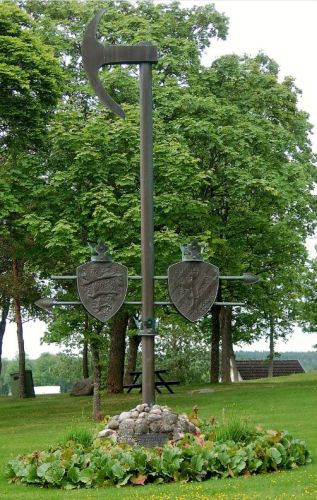
Swedish memorial at the site of the Battle of Hova, north of Mariestad, where an army of Swedish peasants led by King Valdemar Birgersson was beaten by a army of Danish cavalry and German mercenaries led by his brother Magnus Ladelås. The coat of arms on the left with the three lions is the Valdemar Birgersson coat of arms. Photo Janee - Own work in the RAÄ Fornsök database. Wikipedia.
Jutta traveled to Sweden to visit her sister, who was a queen there. She was warmly received by the king, Valdemar Birgersson, so warmly that she became pregnant. The new prioress in the monastery in Roskilde complained to the pope, and the Swedish chieftains forced King Valdemar to make a penitential trip to Rome. The Pope wrote to the Archbishop of Lund that he should have Jutta banded in the churches on all Sundays and holidays.
Back in Denmark, she became involved in trials regarding her paternal inheritance, which was only finally concluded when the Danehof in 1284 ordered king Erik Klipping to hand over the inheritance.
However, while Valdemar Birgersson was traveling to Rome, his brothers Erik and Magnus Ladelås prepared a coup against him. They sought and got help from Erik Klipping in Denmark in the form of 100 hired Danish riders allegedly led by Marsk Stig Andersen Hvide and Count Jakob of Halland. They defeated Valdemar's army at the Battle of Hova in 1275 north of Mariestad. He was then forced to give up his kingship. It is said that Queen Sofie should have said: "Woe to me. I never overcome that grief. Woe to me that my sister ever saw the Kingdom of Sweden."
The deposed Swedish king then began to live openly with his mistresses to a degree which caused the bishops to criticize him for displacing her. In 1277 Sofie returned to Denmark.
Agnes was the youngest of Erik Plovpenning's daughters. In 1263 she was placed in charge of the newly established Sankt Agnete Monastery in Roskilde - that is, at the age of about 14 years. Her sister, Jutta, came to the monastery in 1266 and became a prioress. But - as mentioned above - the ascetic and regular monastic life did not suit them, and they left the nonnery together around 1270, which attracted some attention in the contemporary Denmark. Nothing is known about Agnes' further life.
6. Links and Literature
20200812

























